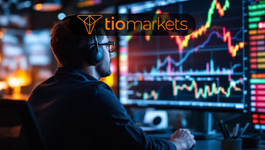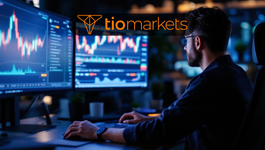What is Margin Trading and How Does It Work?
BY TIOmarkets
|mayo 20, 2024Margin trading is a financial strategy that allows investors to buy securities using borrowed funds. It involves borrowing money from a broker to purchase stocks, bonds, or other assets. This practice can amplify potential profits and losses, making it a high-risk investment strategy. Let's delve into the basics of margin trading to understand how it works.
Understanding the Basics of Margin Trading
Margin trading essentially allows investors to leverage their assets and potentially maximize their returns. By borrowing funds, investors can purchase more shares than they could with their own capital alone. The margin amount that investors can borrow varies depending on the collateral they provide and the broker's requirements.
Margin trading is a strategy that involves borrowing funds to invest in financial securities. This practice can magnify both gains and losses, as investors are essentially using leverage to increase their buying power. It is crucial for investors to understand the risks involved in margin trading, as market fluctuations can lead to significant losses.
Definition of Margin Trading
In simple terms, margin trading is the practice of buying investments with borrowed money. Investors use the cash they own as collateral and borrow additional funds to increase their purchasing power. This borrowed money is known as the margin.
Margin trading allows investors to potentially earn higher returns on their investments by using leverage. However, it also exposes them to greater risks, as they may have to repay the borrowed funds even if their investments decline in value. It is important for investors to carefully assess their risk tolerance and financial situation before engaging in margin trading.
The History of Margin Trading
Margin trading has been around for decades and has played a significant role in the financial markets. It gained popularity in the early 20th century when stock market participation increased. The ability to leverage investments attracted investors looking to amplify their profits.
Throughout history, margin trading has been both praised for its potential to enhance returns and criticized for its role in market volatility. During periods of economic growth, margin trading can fuel market expansion, but during downturns, it can exacerbate market crashes. Regulators have implemented various rules and restrictions on margin trading to mitigate risks and protect investors from excessive leverage.
The Mechanics of Margin Trading
Let's delve deeper into the fascinating world of margin trading to understand the intricacies involved in this financial strategy. Margin trading offers investors the opportunity to amplify their buying power and potentially increase their returns, but it also comes with its own set of risks and considerations that must be carefully managed.
One key aspect of margin trading is the concept of leverage, where investors can use borrowed funds to magnify their market exposure. By only putting up a fraction of the total investment amount, investors can control a larger position in the market. This leverage can lead to enhanced profits in a rising market, but it can also result in magnified losses if the market moves against the investor.
Buying on Margin: A Detailed Explanation
When investors opt to buy on margin, they are essentially entering into a loan agreement with their broker. The initial margin, which is the amount of their own capital they contribute, serves as a form of collateral for the borrowed funds. This initial margin requirement is set by regulatory authorities and can vary depending on the asset being traded and the broker's policies.
It's crucial for investors to understand the risks associated with buying on margin, including the potential for margin calls. A margin call occurs when the value of the investor's account falls below a certain threshold, prompting the broker to demand additional funds to bring the account back to the required level. Failure to meet a margin call can lead to the forced liquidation of assets in the investor's account.
The Role of the Broker in Margin Trading
Brokers play a pivotal role in facilitating margin trading transactions and ensuring the smooth functioning of the market. In addition to providing access to leverage, brokers also help investors navigate the complexities of margin requirements and risk management. They act as gatekeepers, monitoring account activity and stepping in when necessary to protect both the investor and the integrity of the market.
Furthermore, brokers have a legal obligation to disclose the terms and risks associated with margin trading to their clients. This transparency helps investors make informed decisions and understand the potential outcomes of utilizing margin in their investment strategies. By working closely with their brokers and staying informed about market conditions, investors can harness the power of margin trading while mitigating its inherent risks.
Risks and Rewards of Margin Trading
Margin trading comes with both potential profits and substantial risks. Let's look at some of the rewards and dangers associated with this investment strategy.
Margin trading, a practice where investors borrow funds to trade financial assets, offers the potential for amplified gains and losses compared to traditional trading. This strategy allows investors to leverage their positions, essentially multiplying their exposure to the market.
Potential Profits from Margin Trading
One of the main attractions of margin trading is the potential for higher returns. By leveraging borrowed funds, investors increase their buying power and can benefit from price appreciation. If the value of their investments rises, the profits earned will exceed what would have been possible without margin trading.
Moreover, margin trading can provide traders with the opportunity to diversify their portfolios more extensively. With increased capital at their disposal, investors can spread their investments across a wider range of assets, potentially reducing risk through diversification.
Possible Losses and Risks Involved
However, it's crucial to acknowledge the risks involved in margin trading. A decline in the value of the investments can amplify losses. If the value of the securities purchased on margin falls below a certain level, a margin call can be triggered, requiring investors to deposit additional funds or face the forced sale of assets to repay the loan.
Furthermore, the use of leverage in margin trading can magnify the impact of market volatility. While leverage can amplify profits in a rising market, it can also lead to significant losses in a downturn. It is essential for investors engaged in margin trading to have a thorough understanding of the risks involved and to implement risk management strategies to protect their capital.
Key Terms in Margin Trading
Understanding key terms is essential when engaging in margin trading. Let's define some important concepts that investors should be familiar with.
Margin Account: An Overview
A margin account is a type of brokerage account that allows investors to borrow funds against the value of their securities. It provides the leverage necessary for margin trading and allows investors to buy, sell, and hold investments using borrowed money.
Understanding Margin Calls
A margin call occurs when the value of an investor's account falls below a specified threshold set by the broker. When this happens, the broker demands additional funds to restore the account's value to the required level. Margin calls serve as a safeguard to protect brokers and investors from excessive losses.
Strategies for Successful Margin Trading
To navigate the risks associated with margin trading, investors can adopt various strategies. Let's explore some tips for managing risk and optimizing investment outcomes.
Tips for Managing Risk in Margin Trading
First and foremost, it's crucial to have a well-defined risk management strategy in place. This involves setting clear and realistic financial goals, diversifying your investments, and closely monitoring your margin balance. It's also important to have a contingency plan in case the market moves against your positions.
The Importance of Market Research in Margin Trading
Extensive market research is vital before engaging in margin trading. Be sure to analyze the financial health of the companies you invest in, evaluate market trends, and stay informed about economic developments. Being knowledgeable about the industries you invest in can help you make more informed decisions and mitigate risks.
In conclusion, margin trading can be a powerful tool for investors looking to boost their potential returns. However, it is not without risks, and careful consideration must be given to managing those risks effectively. By understanding the basics, being aware of the potential rewards and dangers, and implementing sound strategies, investors can navigate the world of margin trading more confidently.
Start Margin Trading with TIOmarkets
Ready to elevate your trading experience? Join TIOmarkets, the top-rated forex broker, and access a world of opportunities in Forex, indices, stocks, commodities, and futures markets. With over 170,000 accounts opened across more than 170 countries, our platform offers low fees and over 300 instruments in 5 markets. Plus, enhance your trading skills with our comprehensive educational resources and step-by-step guides. Don't miss out on the potential benefits of margin trading.
Create a Trading Account today and start your journey towards successful trading!

Risk disclaimer: CFDs are complex instruments and come with a high risk of losing money rapidly due to leverage. You should consider whether you understand how CFDs work and whether you can afford to take the high risk of losing your money. Never deposit more than you are prepared to lose. Professional client’s losses can exceed their deposit. Please see our risk warning policy and seek independent professional advice if you do not fully understand. This information is not directed or intended for distribution to or use by residents of certain countries/jurisdictions including, but not limited to, USA & OFAC. The Company holds the right to alter the aforementioned list of countries at its own discretion.
Join us on social media

Behind every blog post lies the combined experience of the people working at TIOmarkets. We are a team of dedicated industry professionals and financial markets enthusiasts committed to providing you with trading education and financial markets commentary. Our goal is to help empower you with the knowledge you need to trade in the markets effectively.
Related Posts





